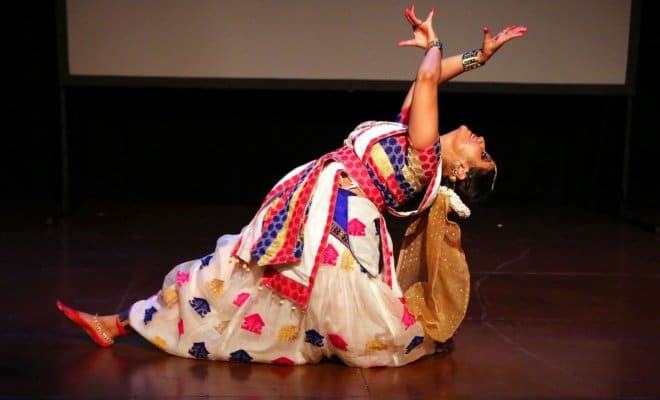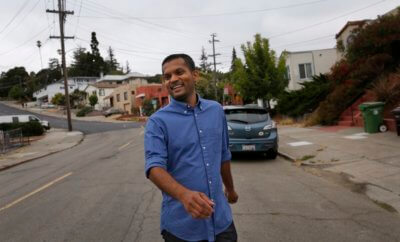Arts
Indian Dance: Motion in Stillness, Stillness in Motion

Anwesa Mahanta performs in the Sattriya style of Indian dance as part of the Drive East festival at La MaMa Experimental Theater in New York.
Photo: Andrea Mohin/The New York Times
Kuchipudi, Kathakali, Bharatanatyam — among the traditional dance-theater forms that Drive East represents — show themselves just as capable of absorbing Western influence as the West has been of absorbing others.
Who expected that New York’s weeklong Drive East season of Indian dance and music would bring us George Harrison’s “My Sweet Lord” arranged as a Kuchipudi number, Shakespeare’s Cleopatra rendered as a Kathakali character, or Édith Piaf’s “La Vie en rose” accompanied by dancing in Bharatanatyam style? But so it was: Kuchipudi, Kathakali, Bharatanatyam — among the traditional dance-theater forms that Drive East represents — show themselves just as capable of absorbing Western influence as the West has been of absorbing others.
Drive East, at La MaMa Experimental Theater’s basement space, has been an annual fixture on the New York calendar since 2013. (This year, it goes to San Francisco, too, Aug. 22-26, with several of the same artists.) It has always represented a generous cross-section of the classical dance forms and musical idioms of India. Wednesday, for example, brought an impressive recital in the Sattriya genre by Anwesa Mahanta; Friday evening three Kathak performers (who also performed at the Battery Dance Festival); and, for the Sunday finale, a superb Carnatic flute trio (Flute Raman).
Since Harrison’s “My Sweet Lord” (1970) invokes Krishna, it ought to be a gift to Indian performers anyway — but the detailed Kuchipudi treatment (Kuchipudi derives from the southeastern state Andhra Pradesh) given by Bhavana Reddy was marvelously judicious. Her percussive footwork enhanced the taped music, her floor patterns and gestures dramatized its spirit with tender vivacity.
This was the shortest item on her program, which featured several traditional Kuchipudi specialties, as when the soloist takes up position on a brass plate: her vibrating feet turn the plate into a traveling percussion instrument while she remains otherwise balanced in serenity. My only objection to Reddy’s recital was that when dancing as a gopi, one of the milkmaids in love with Krishna, she exhibited a winsomeness — repeated, pointed use of the eyes — that became cloying when sustained at length.
In the “Kathak!” program Friday, Piyush Chauhan and Preeti Sharma made a great impression, perhaps because of the indoor space. Dressed in scarlet, they have terrific glamour and flair. It was in their many sudden stops amid speed that I appreciated how Kathak (once associated with the courts of the Indian north) exemplifies a central aspect of Indian dance philosophy: motion in stillness, stillness in motion.
But Drive East, building on advances made last year, is showing other aspects of India’s diversity. These include feminism and dualities of gender (though not yet homosexual love, still a matter of fierce political debate in India). It’s curious that with Drive East and other recent New York presentations of Indian dance, there’s more exploration onstage of gender diversity than feminism.
Kathakali (from Kerala, in the southwest) has almost always been a male form; here, Cleopatra was played by a man, Prabal Gupta, dressed in garb evoking Queen Victoria. Mahanta ended her recital (in the Sattriya idiom, from the northeastern state of Assam) in male attire as one of the demon kings of mythology and his son. Both Sattriya and Kathakali are highly traditional genres; I found it easy to enjoy Mahanta’s presentation of monstrous masculinity, but hard to like (at times, hard to understand) Gupta’s very stylized version of the Egyptian queen (eyebrows vibrating, torso slowly circling above parted thighs).
More conceptually complex was the program “Dualities of Dance: Addressing Gender in Indian Classical Dance.” Kiran Rajagopalan not only performed his recital in female dress but also, in his second number, combined Indian style with Yoruba elements from West Africa. Mesma Belsare, who performed in New York in 2008 as Sudarshan Belsare (then part of the tradition of Stri Vesham, or female impersonation), delivered a virtuoso number, “Shilpa Natana: The Dancing Sculptures,” partly invoking the androgynous mythological archetype Ardhanarishwara. Belsare dances the Bharatanatyam style (associated with Tamil Nadu, India’s south-easternmost state), as did Rajagopalan.
In a panel discussion, both artists said they hoped that they had made themselves transparent and that their dancing had spoken for them. This kind of selfless objectivity is among the most remarkable features (one of the most classical features, too) of the Indian classical arts. I’m afraid, however, that in both cases I was too strongly aware of the intrusive performer. Belsare is elaborately stylish, but with such a heavy veneer of charming dignity that I could never get past it; Rajagopalan’s manner is ponderous.
It’s unfortunate that the most seemingly feminist offering I saw this year, Neha Mondal Chakravarty’s recital, addressed the same Hindu mythological figure — the strong-voiced heroine Draupadi, with her five husbands — as last year’s most feminist item, by Janaki Rangarajan; both were in the Bharatanatyam idiom, and both featured more speech than dance. But legend can supply other inspiring figures for Indian women. In her Sattriya recital on Wednesday, Mahanta played both women and men; and her goddess Lakshmi, in “Shree Vandan,” showed both power and multifaceted expressiveness.
Sattriya is one of the Indian genres in which the dancers wear no ankle bells; it’s also considered a form of theater as much as dance. While the feet carry the dancer around the stage, the upper body often bends vividly. It doesn’t seem a gymnastic form, and yet Mahanta in certain situations arched back memorably — especially in her final “Nrisimha Lila.”
Here she’s the demon Hiranyakashipu (all overwhelming ego) and his defiant son Prahlada (who, by contrast, subordinates himself to Vishnu). At the climax, when Hiranyakashipu (Mahanta) brought Vishnu’s wrath upon himself, she stood on parted feet, arching right back. Her face, wide-eyed, addressed the audience upside down. And — a haunting image of horror — her hands, with fingers parted, descended over her mouth and cheeks, like destructive claws.
© New York Times 2018



